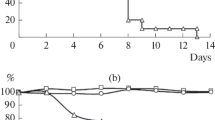Summary
A test for the immunogenicity of influenza viruses is described, which is based upon the intranasal vaccinating dose required to induce inhibition of multiplication of unadapted influenza viruses in the lungs of mice. This test is more sensitive than an antigen extinction procedure, in which immunogenicity is measured according to the dose required to induce the formation of hemagglutination-inhibition antibody. The clearance test has been used to demonstrate that a) influenza A/Northern Territory/60/68 virus is a better imunogen than A/Victoria/3/75 and both are probably superior to A/U.S.S.R./92/77; b) for A/Northern Territory/60/68, vaccination by the intranasal route in 25 g mice is at least 43,600 times more efficient than by the intraperitoneal route and c) common immunogenic relationships exist between various H3N2 viruses and an H1N1 strain.
Similar content being viewed by others
References
Ada, G. L., Yap, K. L.: Matrix protein expressed at the surface of cells infected with influenza viruses. Immunochemistry14, 643–651 (1977).
Biddison, W. E., Doherty, P. C., Webster, R. G.: Antibody to influenza matrix protein detects a common antigen on the surface of cells infected with type A influenza viruses. J. Exp. Med.146, 690–697 (1977).
Braciale, T. J.: Immunologic recognition of influenza virus-infected cells. II. Expression of influenza A matrix protein on the infected cell surface and its role in recognition by cross-reactive cytotoxic T cells. J. Exp. Med.146, 673–689 (1977).
Davenport, F. M., Francis, jr., T.: A comparison of the growth curves of adapted and unadapted lines of influenza virus. J. Exp. Med.93, 129–137 (1951).
Dulbecco, R., Vogt, M.: Plaque formation and isolation of pure lines with poliomyelitis viruses. J. Exp. Med.99, 167–182 (1954).
Effros, R. B., Doherty, P. C., Gerhard, W., Bennink, J.: Generation of both cross-reactive and virus-specific T-cell populations after immunization with serologically distinct influenza A viruses. J. Exp. Med.145, 557–568 (1977).
Fazekas de St. Groth, S., Donnelly, M.: Studies in experimental immunology of influenza. IV. The protective value of active immunization. Aust. J. Exp. Biol. Med. Sci.28, 61–75 (1950).
Feery, B. J., Gallichio, H. A., Rodda, S. J., Hampson, A. W.: Antibody responses to influenza vaccines containing A/U.S.S.R./90/77. Aust. J. Exp. Biol. Med. Sci.57, 335–344 (1979).
Gill, P. W., Murphy, A. M.: Naturally acquired immunity to influenza Type A. Med. J. Aust.2, 329–333 (1976).
Gill, P. W., Murphy, A. M.: Naturally aquired immunity to influenza Type A: a further prospective study. Med. J. Aust.2, 761–765 (1977).
Hackett, C. J., Askonas, B. A., Webster, R. G., Van Wyke, K.: Quantitation of influenza virus antigens on infected target cells and their recognition by cross-reactive cytotoxic T cells. J. Exp. Med.151, 1014–1025 (1980).
Hoskins, T. W., Davies, J. R., Smith, A. J., Miller, C. L., Allchin, A.: Assessment of inactivated influenza-A vaccine after three outbreaks of influenza A at Christ's Hospital. Lancet1, 33–35 (1979).
Lu, L. Y., Askonas, B. A.: Cross-reactivity for different type A influenza viruses of a cloned T-killer cell line. Nature (London)288, 164–165 (1980).
McLaren, C., Williams, M. S., Bozeman, F. M., Mayner, R. G., Grubbs, G. E., Bavthlow, W. E., Staton, E., Ennis, F. A.: Comparative antigenicity and immunogenicity of 1976 influenza virus vaccines: results of mouse protection experiments. J. Biol. Stand.6, 315–330 (1978).
Murphy, B. R., Rennels, M. B., Douglas, jr., R. G., Betts, R. F., Couch, R. B., Cate, jr., T. R., Chanock, R. M., Kendal, A. P., Maassab, H. F., Suwanagool, S., Sotman, S. B., Cisneros, L. A., Anthony, W. C., Nalin, D. R., Levine, M. M.: Evaluation of influenza A/Hong Kong/123/77/ (H1N1)T s-1A2 and cold-adapted recombinant viruses in seronegative adult volunteers. Infect. Immun.29, 348–355 (1980).
Nelder, J. A., Wedderburn, R. W. M.: Generalized linear models. J. Roy. Stat. Soc.A 135, 370–384 (1972).
Palmer, D. F., Dowdle, W. R., Coleman, M. T., Schild, G. C.: Advanced laboratory techniques for influenza diagnosis. Immunology Series No. 6 Procedural Guide. U.S. Dept. Health Education and Welfare, Public Health Service, Center for Disease Control, 25–63 (1975).
Reed, L. J., Muench, H.: A simple method of estimating fifty per cent endpoints. Amer. J. Hyg.27, 493–497 (1938).
Schild, G. C.: Evidence for a new type-specific structural antigen of the influenza virus particle. J. gen. Virol.15, 99–103 (1972).
Schulman, J. E., Kilbourne, E. D.: Induction of partial specific heterotypic immunity in mice by a single infection with influenza A virus. J. Bact.89, 170–174 (1965).
Smith, J. B.: Survey of laboratory animals being maintained in Australia, 3rd revision. John Curtin School of Medical Research, Australian National University, Canberra, Australia, 1 (1979).
Wang, C.-I.: The relation of infectious and hemagglutinin titers to the adaption of influenza virus to mice. J. Exp. Med.88, 515–519 (1948).
Warburton, M. F.: The immunogenicity of influenza virus vaccines. PhD thesis, Australian National University, Canberra, 63–65 (1963).
Wark, M. C., Tannok, G. A., Sutherland, M. M., Smith, L. E.: A murine model for assessment of living attenuated influenza A vaccines. Aust. J. Exp. Biol. Med. Sci.58, 615–626 (1980).
World Health Organization: Preliminary tests of influenza vaccines A (H1N1). Wkly Epidem. Rec.7, 51 (1978).
Yap, K. L., Ada, G. L.: The recovery of mice from influenza A virus infection: adoptive transfer of immunity with influenza virus-specific cytotoxic T lymphocytes recognizing a common virion antigen. Scand. J. Immunol.8, 413–420 (1978).
Author information
Authors and Affiliations
Additional information
With 6 Figures
Rights and permissions
About this article
Cite this article
Tannock, G.A., Wark, M.C., Smith, L.E. et al. A clearance test in mice using non-adapted viruses to determine the immunogenicity of influenza strains. Archives of Virology 70, 91–101 (1981). https://doi.org/10.1007/BF01315003
Received:
Accepted:
Issue Date:
DOI: https://doi.org/10.1007/BF01315003




